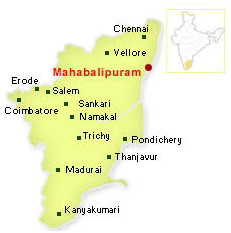

The ancient port town of Mamallapuram is selected for the scheduled visit of Prime Minister Narendra Modi and Chinese President Xi Jinping during a two-day second India-China informal summit from October 11.
Context
The ancient port town of Mamallapuram is selected for the scheduled visit of Prime Minister Narendra Modi and Chinese President Xi Jinping during a two-day second India-China informal summit from October 11.
About
- First India-China informal summit: It was held in Wuhan, China on April 27-28, 2018, to exchange views on overarching issues of bilateral and global importance, and to elaborate their respective visions and priorities for national development in the context of the current and future international situation.
About Mamallapuram:
- Mahabalipuram or Mamallapuram is a historic city and UNESCO World Heritage site in the state of Tamil Nadu.
- Mahabalipuram was the second capital of the Pallavas who ruled Kanchipuram. Formerly, mahabalipuram was known and called as Mamallapuram.
- It was during the reign of King Narasimha Varman I(630 - 668AD), the name Mahabalipuram was changed. King Narasimha Varman I was a great and valiant warrior. He was given the title Mamalla which means ‘the great wrestler’ so the name was converted from Mahabalipuram to Mamallapuram considering the great king and his achievements.
- During the reign of the Pallava dynasty, between the 3rd century CE and 7th century CE, it became an important centre of art, architecture and literature.
- Mahabalipuram was already a thriving sea port on the Bay of Bengal before this time. A significant amount of coins and other artefacts excavated from this region also indicate a pre-existing trade relation with the Romans even before it became a part of the Pallava Empire.
Art & Architectural Masterpieces at Mamallapuram:
- Shore Temple: The Shore Temple (built in 700–728 AD) is so named because it overlooks the shore of the Bay of Bengal. It is a structural temple, built with blocks of granite, dating from the 8th century AD. It was built during the reign of Narasimhavarman II. It is a remnant of a larger complex of temples and civil structures much of which lie under the depth of the sea now.
- Descent of the Ganges: It is alternatively known as Arjuna’s Penance. Descent of the Ganges is a gigantic open air bas-relief sculpted out of pink granite. The dramatic relief sculpture narrates the tales from Indian epics such as the Mahabharata.
- Pancha Ratha: Pancha Ratha (five chariots) is an architectural ode to Mahabharata’s five Pandava brothers Yudhistir, Bhima, Arjuna, Nakula, Sahadeva, and their wife Draupadi. Thematically and structurally, each ratha is significantly different from the other ones, but all of them were carved out of a long stone or monolith.

